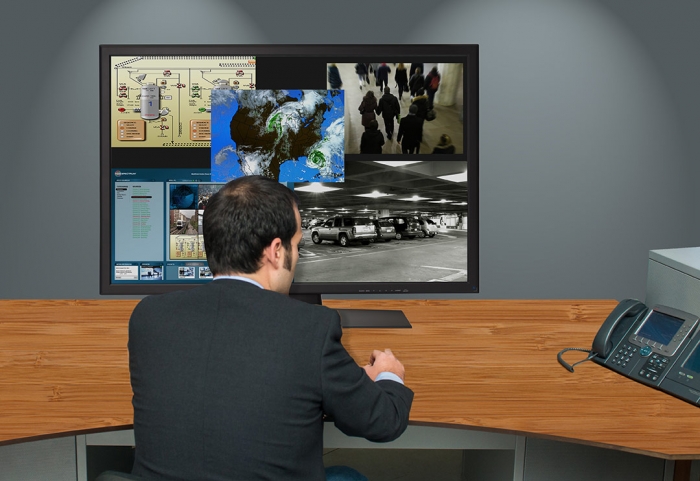Applications of 4K UHD Technology in Control Room Design
Original photo courtesy of Viappy / Shutterstock
4K ultra high definition (UHD) resolution offers considerable value in control room environments. Delivering 3840x2160 (8.3 million) pixels per display, it significantly enhances an operator’s ability to monitor finely detailed imagery. However, the limitations imposed by human vision raise some interesting questions about 4K deployment. What applications can benefit most from this higher pixel density and, by extension, in which situations is the incorporation of 4K UHD processing technology most effective?
Viewing Distance vs. Resolution
Human vision is confined to a narrow spectrum of wavelengths and resolutions. The eye is capable of resolving various densities and sizes of pixels, but this ability is greatly affected by the distance between the operator and display, the “viewing distance.”
Display devices are available in a wide range of sizes. The smaller the screen or monitor, the more densely packed its pixels will be, and the closer you would need to be to discern a visible difference between lower and higher resolutions.
The display size and the typical viewing distance are two critical criteria that help determine the situations in which 4K UHD resolution adds value to an application. The following chart compares screen size and pixel density and illustrates the ideal viewing distances for each combination:
This excellent chart was produced by Carlton Bale. Please read his full article on this topic.
As the chart shows, if you are viewing 4K signals on a small screen of ~50 inches, your ideal viewing distance is no more than about five feet. If you are farther away than this, imagery on a 4K display will effectively appear identical to that on an HD display. With 4K imagery on a larger screen, e.g. 105 inches, the ideal viewing distance increases to 12-15 feet. In contrast, the ideal viewing distance for a ~50 inch 1080p HD display is approximately 12-15 feet, and 15-20 feet for a 105 inch 1080p display.
Bezels and Video Walls
When constructing a multi-monitor video wall, another consideration is the total amount of continuous display space between monitor bezels. Bezels provide a rigid support structure for the panels (“glass”) in a display. However, on a video wall, bezels also break up the continuous appearance of images that may be scaled over multiple monitors. With a 4K UHD video wall, you can use larger format display devices, reducing the total number of bezels on the wall. If continuous imagery is important to your application, then 4K UHD resolution monitors offer this added benefit.
4K UHD Video Wall Placement
If you need to construct a video wall with the fewest bezels possible and your wall will likely be viewed from a maximum distance of 10-15 feet, then a very large format 4K UHD display (84”-104”) may be the best fit for your installation. In contrast, if you want to use smaller monitors, and/or plan to view the wall from farther away, then 1080p displays may be a more cost-effective choice for your application.
Most control room applications typically involve work stations located a specific distance from a central video wall, so the viewing distance/display size guidelines can help you choose what kind of a wall is most appropriate for your system. RGB Spectrum’s new MediaWall V display processor can configure a range of resolutions for display on either 4K UHD or 1080p HD video walls.
Notable Exceptions
Some video wall applications are apparent exceptions to the guidelines above because they often require close-up inspection of ultra high resolution imagery. These include:
- Medical imaging
- Simulation modeling such as oil & gas exploration
- Manufacturing inspection systems
- Aerial reconnaissance
- Megapixel surveillance
In these cases, users needing more visibility are likely to walk right up to a video wall, shortening their viewing distance of imagery so much that it makes sense to choose the highest resolution displays. 4K UHD processing equipment and video wall monitors are a logical choice in applications like these where minute details matter and video wall imagery may be subjected to close-up inspection.
Don’t Forget About Inputs
If you choose to build a video wall out of 2K HD displays, does a 4K UHD processor still have value? Absolutely. Typically, a variety of input signals will feed into a processor for display on a video wall, and these images may be spread out across multiple monitors. The pixel density of the input will determine how large it can be expanded on a video wall without negatively impacting clarity.
For example, a 2K HD (1920x1200), 24-monitor video wall array offers a total of 55 million pixels, enough real estate to display seven 4K input signals at full resolution. However, the lower pixel density of the monitors means that those 4K UHD signals can be spread out across more video wall monitors (expanded to a larger size) while still maintaining image quality. This use case is particularly relevant for installations with very large walls that require the display of finely detailed imagery such as multi-megapixel surveillance, satellite telemetry, industrial control applications, and geospatial modeling.
With 4K UHD inputs you have the pixel density required to configure large windows on a large wall, regardless of whether that wall is built with 2K HD or 4K UHD displays.
Put a Wall On Your Desk
A 4K workstation monitor packs 8.3 million pixels into a desktop size display. What are the applications of this deployment of 4K technology?
Video wall imagery is typically composed of windows containing graphics or video content provided by a source system like a computer or set top box. Today, most source systems output 1080p video that would entirely cover one 1080p monitor if displayed unscaled.
However, if you have 4K UHD monitors and use an RGB Spectrum MediaWall V processor, you could display four full-resolution (unscaled) 1080p input windows on a single 4K UHD monitor. To take this further, you could divide each 1080p window into three D1 sub-windows, up to 24 CIF sub-windows, or 81 QCIF sub-windows. Thus, a single 4K UHD monitor could be used to display up to 324 QCIF images at full, unscaled resolution.
If you create a user workstation with three 4K UHD displays, then an operator could monitor 972 full resolution QCIF cameras feeds. That is a lot of data, and it could all be displayed on a single user workstation using the MediaWall V processor.
In fact, one MediaWall V processor could drive up to four such multi-monitor workstations. In this scenario, one large 4K wall would effectively be broken up into four smaller “desktop walls”, which would offer operators all of the benefits of 4K resolution. For added functionality, the MediaWall V processor is compatible with RGB Spectrum’s Enterprise MCMS, a powerful control room system that allows operators to share keyboard and mouse control over system resources. The result is a customizable workstation-based control room solution with incredibly powerful UHD video display capabilities.
Who Needs a Desktop Wall?
A 4K desktop wall is appropriate for anyone who needs to track real time video/graphic information from a multitude of sources: e.g. traffic management centers, casinos, municipal emergency operations centers, central station surveillance companies, and more. The pixel density provided by a 4K desktop wall results in unsurpassed image clarity, no matter how closely an operator views the monitors.
Conclusion
With RGB Spectrum’s MediaWall V display processor for 4K UHD/2K 1080p video and graphics, you can support a variety of control room configurations: large 4K video walls, large 2K video walls, 4K “desktop walls”, 2K “desktop walls”, or a combination of video walls and “desktop walls”. The MediaWall V processor configures 4K UHD, 2K HD, and standard lower resolutions inputs to delivers superb image quality on large or small video walls.
RGB Spectrum is a leading designer and manufacturer of mission-critical, real-time audio-visual solutions for a civilian, government, and military client base. The company offers integrated hardware, software, and control systems to satisfy the most demanding requirements. Since 1987, RGB Spectrum has been dedicated to helping its customers achieve Better Decisions. Faster.™



